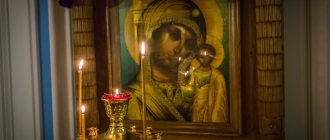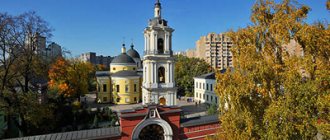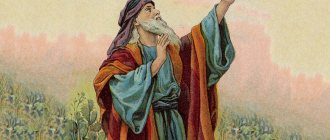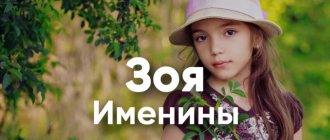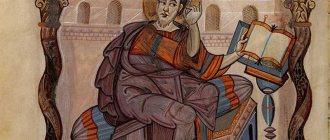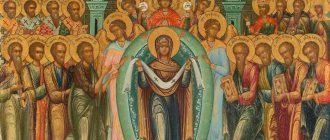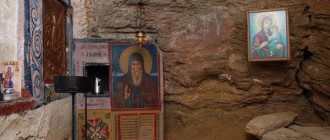Preface
The entire history of human holiness is a revelation of the possibilities to which God calls man. From the fall of our first parents until the Coming of Christ, these possibilities were unattainable; man was not able to heal his own nature, damaged by sin. This era, the contradictory era of the Old Testament, showed us an example of holiness before Christ, the miracle of following the Light in complete darkness, the power of faith in the One who has not yet come. The holiness of the Old Testament united opposites, for it existed in a fragmented world - until God became man, uniting the strongest division that can exist.
The Incarnation returned man to the path he should have followed. The highest heights are open to us: we are called to become sons of God by grace. But having fully realized the power of this call, a person is lost in bewilderment: can anyone fulfill it? Together with the Monk Isaac the Syrian, he can ask: “How will I achieve this ineffable entrance?” We call Christ the Firstborn of our salvation - as the new Adam, the first Man of the new Life. But did anyone follow Him, did anyone become a second man, a “brother” of this Firstborn, a brother by adoption, by grace? And here the words of the Savior echo to us: Who are My Mother and My brothers?
(Matt. 13:48). This is what Christ said, refusing to go out to the Most Pure Virgin from the house where the disciples were listening to Him. In this answer of the Savior they often saw the humiliation of the Mother of God, but truly in these words is Her true greatness: here is a person worthy of being called His Mother not only in the flesh, but also in the spirit! “Mother” and “brother” of Christ are those who fulfilled His word, but no one fulfilled His word like the Most Pure Virgin. Her holiness is incomprehensible, Her greatness is above thought and word, but at the same time it is not closed to us, for the Most Holy Mary is a person similar to us. She is higher than the Cherubim and Seraphim; Saint Gregory Palamas teaches us that every person is by nature more perfect than an Angel, but cannot reveal this perfection, remaining under sin. We call Mary the “Most Honest Cherub” not only because of the greatest miracle of the Incarnation, but also because of Her personal holiness. The Blessed Virgin has reached the state to which each of us is called. She never sinned - and became the Gift that old humanity brought to God, a gift more valuable than the whole world, a gift for which we are not ashamed.
These are the two limits within which the manifold experience of human holiness extends: the glimmers of light in darkness and the Light that consumes all darkness. Between these lines there is one more person whose earthly service will never be repeated. We often call him the last prophet of the Old Testament, but he is also the first prophet - the only prophet who met the One he proclaimed, who preached not only about the Coming, but also about the Coming. This is John, the greatest of those born of women, unique in his ministry, a prophet foretold by the prophets (cf. Mal. 3:1), a messenger who anticipated the apostles.
The Apostles continued the ministry of the Forerunner, one might say, in a reverse perspective: John prepared the people for the Coming of the Lamb, Who takes away the sin of the world
(John 1:29), the apostles testified to the accomplished Redemption;
John preached only in the Judean desert and baptized in Aenon, near Salem
(John 3:23), and mainly only the Jews heard him; the apostles went around the whole world, calling all nations to the “feast of the Kingdom.”
In the holiness of the Most Pure Virgin, the Forerunner and the Apostles, the first fruit of the evangelical faith appeared, fruit in abundance, a hundredfold,
and not at sixty or thirty (cf. Matt. 13:23).
This holiness is the beauty of the renewed world, koatsos toi koatsoi, in the wonderful expression of one of the teachers of the Church. This is the beauty of the Lord
(cf. Ps. 26:4), in which we see our salvation, according to the word of St. Athanasius of Alexandria. And we hope that the proposed book, which tells about the earthly life of the Most Holy Theotokos, John the Baptist and the Apostles, will convey a glimpse of this beauty.
The source for this narrative was the books: “The earthly life of the Most Holy Theotokos and a description of Her miraculous icons, revered by the Orthodox Church, on the basis of the Holy Scriptures and church traditions” by Sofia Snessoreva, “The Holy Great Prophet, Forerunner and Baptist of the Lord John” by Archpriest Simeon Vishnyakov and “Life and the works of the glorious and all-praised twelve apostles of the Lord, the seventy lesser apostles and other equal-to-the-apostles evangelists of Christ.”
Maxim Kalinin
Church Fathers on the Mother of God
Saint Germanus, Patriarch of Constantinople:
“If You had not interceded, Theotokos, no one would have appeared holy... no one can be saved except by You, Theotokos.”
Saint Gregory Palamas:
“She is the only boundary between created and uncreated nature; no one would come to God if it were not for She and the Mediator born from Her; and neither Angels nor men would have gifts from God except through Her.”
Hieromartyr Dionysius the Areopagite:
“I bear witness to God that, besides God himself, there is nothing in the universe so filled with Divine power and grace. No man can comprehend with his mind what I saw. I confess before God: when I was brought before the face of the Blessed Virgin by John, shining among the apostles, like the sun in the sky, I experienced an inexpressible feeling. Some kind of Divine radiance shone before me. It illuminated my spirit. I felt the fragrance of indescribable aromas and was filled with such delight that neither my weak body nor my spirit could bear these signs and the firstfruits of eternal bliss and heavenly glory. From Her grace my heart fainted, my spirit fainted. If I had not remembered your instructions, I would have considered Her to be the true God. It is impossible to imagine greater bliss than what I felt then.”
Saint Philaret of Moscow (Drozdov):
“Is it possible to follow in the footsteps of the Mother of God? - Not only can this happen, but it must also happen - according to the prophet’s prophecy: virgins will be brought to the King after Her (Ps. 45:15). A person can also imitate the God-Man, Who Himself calls to this and encourages the achievement of a high goal: whoever serves Me, let him follow Me; and where I am, my servant also will be (Wed: John 12:26). Imitation does not require equality, or even close to equality. The small can imitate the great in what is available. The wondrous and wonderful is not available to every desire; but the true and good are available to everyone, although, however, to each in their own measure and degree, according to the degree of faith, according to the degree of purity of desire and zeal in deed. Although the fate of the Most Holy Theotokos, in its special form and degree, is unparalleled, in general, as the fate of a perfect and blessed soul, it is a consequence of the same forces, dispositions, actions and exploits that pave and accomplish the path of salvation common to all people.” .
Holy Righteous John of Kronstadt:
“How holy is the Lady Theotokos, with Whom God the Word Himself most sincerely united, the ever-present Light, the true Light, enlightening every person coming into the world, upon whom the Holy Spirit descended and upon whom the power of the Most High overshadowed (See: Luke 1:35) ! How holy and all-holy is the Lady Theotokos, Who became the temple of the Divinity not made by hands and was completely imbued, in all thoughts, feelings, words and deeds, with the Holy Spirit, and from whose blood the Creator Himself made flesh for Himself? Truly all-holy, firm, unshakable, unchangeable throughout all eternity in Her highest, divine holiness, for the all-perfect God, who became Her son according to humanity, made Her all-perfect for Her greatest humility, love for purity and for the source of purity - God, for Her perfect renunciation from the world and clinging with all her thoughts to the heavenly Kingdom, and - especially because She became His Mother, carried Him in the womb, then in Her most pure hands, nourished the One who nourishes all creation with pure milk, kept Him, caressed Him, was sick and grieved for In Him, she shed tears for Him, lived all her life for Him, only for Him alone, she was all immersed in His spirit and was one heart, one soul with Him, one shrine with Him! Oh, the highest unity of love and shrine of the Most Pure Virgin Mary and Her Divine Son, the Lord Jesus Christ!”
Metropolitan Anthony of Sourozh (Bloom):
“She loved Him like a mother, and She worshiped Him like God. And She never stood as an obstacle on His way of the cross. Nowhere in the Gospel will you find a place where the Mother of God stops Him, like Peter, saying: “Do not allow this (that is, the cross and death) to happen to You...” Christ answered Peter: “Get away from Me, you are My opponent and enemy, you think about human things, and not about God’s…” The Mother of God, the Virgin Mary, never stood as an obstacle on this path. She allowed Him to walk the entire way of the cross, and at the foot of the Cross she did not utter a single word, did not utter a single prayer out loud that would go against the will of the Father and the will of the Son. She stood there and did not protect Her Son from the tormentors with a word, did not stop the scoffers and scoffers with a word, did not turn to the Father with a word; did not cry out: “Send, O Lord, Thy help, that Thy enemies may be scattered!” No, She, in complete unity, united to the end with the will and love of Her Son, gave Him to death so that others might live.”
7.04.2020
The earthly life of the Blessed Virgin Mary
TEACHING OF THE ORTHODOX CHURCH ABOUT THE MOTHER OF GOD
Rejoice, height beyond the reach of human thoughts.
Before the world existed, the Virgin Mary was pre-elected in the Eternal Council of the Most Holy Trinity to serve the salvation of the human race.
Like the dawn of Redemption, the Most Pure Virgin shone at the time when our ancestors, having transgressed the commandment of their Creator, listened in fear and trembling to the terrible sentence of the Just Judge; already in this sentence the gracious promise of His goodness to fallen creatures shone forth: The seed of the woman will erase the head of the serpent
(cf. Gen. 3:15); and this first of all Divine promises was revealed in all subsequent events of the representative time, and with increasing accuracy as the predetermined time approached.
The Lord repeated this promise repeatedly to prepare the people to receive the promised Savior of the world; it was not erased from the memory of people even after they were scattered across the face of the earth; beyond the distant mountains and seas they carried with them this gratifying, albeit distant, hope. Centuries passed after centuries, peoples disappeared, new countries appeared, regulations and customs changed, but faith in the Savior coming from the Most Pure Virgin remained unshakable. Five thousand years passed in anticipation, and finally, at the time determined by the destinies of God, all the prophecies were fulfilled, the shadows of the Old Testament disappeared and the Guiding Star appeared on the horizon of the universe to lead perishing humanity to a saving haven.
All the events of the Old Testament represent, as it were, a shadow or pre-image of New Testament persons and events and have as their main subject the Savior of the world - our Lord Jesus Christ, born of the Blessed Virgin.
The primeval, virgin soil, not cultivated by human labor, not watered by rain, grew all the diversity and splendor of plant nature and served to create the body of the first man: this, according to the holy fathers, is the first indication of the Virgin Mary, from whom God the Word was pleased to become incarnate. The Most Pure Virgin, like an animated Paradise, manifested in Herself the wondrous fruits of the virtues, had the Lord in Herself - “the tree of life, planted by God in the beginning with food-bearing and giving birth” - and in Him she gave people deliverance from eternal death and bestowed Eternal Life, just as the Lord Himself did Jesus Christ said: Eat my flesh and drink my blood, you will have eternal life, and I will raise him up on the last day
(John 6:54). From Eve, the first wife to sin, the entire human race came to earth, born in suffering and for suffering; Through the fall of Eve, death was introduced into the world and man was expelled from Paradise. The Virgin Mary brought Eternal Life to the world in the God-man born by Her and returned eternal bliss to people.
Patriarch Noah built an ark from rotting wood for a hundred years and in this ark he and his family were saved from the Flood; in this one can see a clear pre-image of the Most Pure Virgin Mary, from Whom Christ is born, offering true salvation to all who believe in Him and come running under the sovereign protection of His Most Pure Mother. The post-Flood world was populated by Noah and his children; Christians, children of the New Testament, trace their origins to Christ, born of the Virgin Mary. The dove that Noah released from the ark and brought him an olive branch represents the Virgin Mary, who gave birth to the Savior of the world from the flood of sin and with His birth heralded the end of the wrath of God and perfect peace on earth.
Patriarch Jacob had a mysterious vision in which he was shown a ladder, with its base established on earth, and its top reaching to Heaven; The Holy Church calls the Virgin Mary a spiritual ladder, born from the earth and connecting the earth with Heaven; through Her, as through a ladder, God descended to earth and opened the entrance to the Kingdom of Heaven to all His faithful followers who resort to the protection of the Mother of the Most High God.
Moses saw the image of the Mother of God in a bush that was burning and did not burn. What was represented by the flame and the bush was clearly revealed in the mystery of the Virgin: the bush burns and is not consumed, the Virgin gives birth to Light and remains incorruptible. For this reason, the Holy Church calls the Mother of God the burning bush, and She is often depicted surrounded by a fiery radiance.
The pillar of cloud, which overshadowed the Israelites during the day and illuminated them at night with a fiery light, led by Moses from Egypt, is an indication of the Ever-Virgin Mary as a luminous cloud that carried God, leading people to the land of promise, to the Kingdom of Heaven, pouring out on them the life-giving source of God’s mercy and grace.
In the Red Sea, which passed through the dry bottom of the Israelites and drowned Pharaoh and his hordes, we see the image of the Unworn Bride, who, through the immaculate birth of Jesus Christ, became a sea of destruction for the mental, proud Pharaoh and the waters of salvation, an irresistible wall for the faithful who meekly bear their cross behind Her Divine Son[1].
When the Israelites, wandering through the waterless desert, suffered thirst from lack of water, Moses, at the command of God, struck a stone mountain with his rod - and water flowed out from there, quenching the thirsty; The Most Holy Virgin, through the birth of our Lord Jesus Christ from Her, became the source of grace that quenches the thirst for Eternal Life.
The land of Canaan, promised to the Israelites, was fruitful; it was “boiling with milk and honey,” according to the expression of Holy Scripture. The Most Holy Virgin, who gave us the bread of life, is the true promised land, from which honey and milk flow.
The Israelites, according to God's commandment, had separate cities in which unintentional murderers could have a safe refuge. The Most Holy Virgin is a “city of salvation” for believing souls, a haven, a fence, an affirmation and a sacred refuge.
God fed the Jews with manna that fell from heaven; a golden vessel filled with this Heavenly bread was placed in the Ark of the Covenant, and in this the Holy Church sees the image of the Mother of God. “Thou didst bear Christ,” the Holy Church sings to Her, “the manna of reason, which rained down upon all who worshiped Thee.” The Ever-Virgin Mary contained the manna of life, Christ, who came into the world to save sinners and satisfy the souls of believers with the bread of immortality.
The Tabernacle of Moses and the Temple of Solomon were filled with the glory of the Lord as soon as they were consecrated: the Most Holy Virgin is the most pure temple of the Savior and the sacred treasure of the glory of God, the container of the incontainable God.
The place where the Ark of the Covenant was located was called the Holy of Holies and was accessible to one high priest, and only once a year, when he entered there to sprinkle sacrificial blood: a clear pre-image of the Mother of God as the receptacle of the incarnate Word of God. “Rejoice, great Holy of Holies,” the Church sings to Her. The ark of the Covenant, covered with gold inside and out, contained the tablets of the Law: from the ark of the shrine of the Most Pure Virgin, gilded by the Holy Spirit, the Lord the Lawgiver Himself appeared.
Aaron's dry rod flourished and was placed in the ark as a keepsake for future generations. The Most Holy Virgin came from barren parents and is truly a mysterious rod, an unfading color...
Burning incense before the Lord means offering prayer to the throne of the Most High, therefore the golden censer, which was located behind the second veil of the tabernacle, represents the image of the Blessed Virgin. “Rejoice, Censer, golden vessel, Rejoice, pleasant censer of prayer,” the Holy Church sings to Her, teaching us to resort to the Mother of God as our zealous Intercessor, an indefatigable Prayer Book for the satisfaction of our sorrows.
The lamp with seven unquenchable lamps, which was in the tabernacle, again forms the Most Pure Virgin, who gave birth to the True Light, which enlightens every person who comes into the world, and illuminates with eternal life those sitting in darkness and the shadow of death.
The meal made of rotting wood, which was in the tabernacle for placing twelve loaves of bread on it as a sacrifice to God, is a pre-image of the Ever-Virgin, Who contained within Herself the bread that came down from Heaven - Christ, feeding us for Eternal Life.
The copper laver, built in the courtyard of the tabernacle for the washing of the priests, prefigures the Most Pure Virgin, from Whom the Lord Jesus Christ was born, who opened for everyone access to Holy Baptism, in which believers are washed from spiritual impurity. “Rejoice, bath that washes the conscience,” the Church sings to the Mother of God.
The Israelites, at the direction of Moses, sacrificed animals without physical defects to God; The Most Pure Virgin, while still a three-year-old baby, was brought to the temple by her parents as the purest and most immaculate sacrifice.
When the Angel announced to Gideon, the judge of Israel, the will of God about his election to save the people from the power of the pagans, then Gideon wanted to receive confirmation that there was a blessing from God for this, and he himself chose a sign for this: if on the fleece he laid on the threshing floor at night the dew will fall, and the earth around him will be dry, which means his election is pleasing to God - it has come true.
The very next night, at his own request, the fleece remained dry, and the ground all around was covered with dew. The fleece watered with dew symbolizes the Most Pure Virgin, watered by the Heavenly and Divine rain that descended on Her. “Your most pure womb Gideon saw, the Pure Virgin, in tenderness like rain, the Word descended and became incarnate as the Divine Spirit,” sings the Holy Church. Gideon's fleece was dry, and the ground was wet with dew; and the Virgin Mary remained a Virgin after the birth of the Lord, while the earth was moistened with the dew of true faith in Christ the Savior.
Three youths - Ananias, Azariah and Misail - were not afraid of the rage of the king of Babylon and did not worship the creature instead of the Creator, for which they were cast into a fiery furnace and were preserved unharmed by the power of the Most High: this represents the Virgin who conceived the Creator of the world and was not scorched by the fire of the Divine. Just as the fiery furnace served for the youths not as an instrument of destruction, but of life and renewal, so through the Most Holy Virgin the world achieved its renewal.
The Word entered into the Virgin and, having taken on flesh, preserved Her incorruptible, and this is represented by the prophet Jonah, who was preserved unharmed in the belly of a whale[2].
Everything hidden in the transformations of the Old Testament is revealed with greater clarity in prophecies. The first prediction about the Mother of God lies in the promise of the Redeemer given in Paradise, following the fall of our first parents: the seed of the woman will erase the head of the serpent;
this seed is our Lord Jesus Christ, born of the Virgin Mary.
As the time approaches at which the Redeemer of the world was to appear on earth, prophecies about this phenomenon are pronounced with increasing clarity. The royal prophet David proclaimed many accurate predictions. Singing the glory of the Messiah, he prophesies about the Most Pure Virgin: All the glory of the Tsar's Daughter is within. The Queen appears at Your right hand, adorned in gilded robes
(Ps. 44, 14, 10).
All the Old Testament prophets proclaimed a great event coming into the world through the Most Pure Virgin. The greatest of the prophets, Isaiah, exclaimed about Her: Behold, the Virgin will conceive and give birth to a Son, and they will call His name Immanuel
(Is. 7:14). The Old Testament clearly states that the Mother of God will come from the line of David, will give birth to a Son without a husband, and at His birth will remain a Virgin, that She will be adorned with all virtues and glorified.
With a deeply believing soul, let us bow before the greatness of the Most Pure Virgin, Mother of our Lord Jesus Christ! Let us call on Her to help our weaknesses: we, due to our powerlessness, cannot find words to worthily glorify the Mother of our God, the zealous Intercessor for us sinners.
NATIVITY OF THE HOLY VIRGIN
Thy Nativity, O Virgin Mother of God, is a joy to proclaim to the whole universe.
The Most Holy Mother of God was born from elderly barren parents in the city of Nazareth, lying on a mountain slope, three days away from Jerusalem. In all Galilee there was no town more unimportant than Nazareth; Can anything good come from Nazareth (John 1:46), the Jews said when they heard that the great prophet Jesus had appeared from there.
According to the predictions of the prophets, the promised Savior of the world was to come from the royal tribe of David. But since the Babylonian captivity, the descendants of King David little by little lost their rights, and when the Maccabean tribe rose, all the distinction of the royal tribe disappeared, and it became along with the common people.
When, at the time predicted by the prophets, the royal scepter passed to the foreigner Herod[3]; when the iron kingdom came, destroying everything; when a general decline in morality and religion was revealed, then the Jews realized that the weeks of Daniel were coming to an end, and began to eagerly await the appearance of the Messiah, hoping to see Him in the form of a great conquering king who would free them from the foreign yoke and give them dominion over others peoples.
In Nazareth lived a pious couple - Joachim and Anna. Joachim came from the tribe of Judah, a royal tribe, Anna was the youngest daughter of a priest from the tribe of Aaron, Matthan, who had three daughters: Mary, Sovia and Anna; Sovia had a daughter, Elizabeth, who was the mother of John the Baptist. Joachim and Anna were righteous before the Lord and kept His commandments with a pure heart and were known to everyone not so much for the nobility of their origin, but for their humility and mercy.
Thus they reached a ripe old age. Their whole life was imbued with love for God and mercy for their neighbors: annually they allocated two-thirds of their significant income: one was donated to the temple of God, the other was distributed to the poor and strangers; the rest was used for their own needs. They were happy, but childlessness filled their hearts with sorrow: according to the concepts of that time, childlessness was considered dishonor and a severe punishment, all the more regrettable because the descendants of David were given the hope of becoming instruments of salvation for the human race through the birth of the promised Messiah.
50 years of their married life passed, and they endured the reproach of childlessness. According to the law supported by the Pharisees, Joachim had the right to demand a divorce for his wife’s infertility; but Joachim, a righteous husband, loved and revered his wife Anna for her extraordinary meekness and high virtues and did not want to be separated from her. With heartfelt sorrow, but resignedly, they bore the burden of the test and continued to lead their lives in fasting, prayer and alms, strengthening each other with mutual love and without losing hope that God is always able to have mercy on His servants.
On great holidays they used to go to Jerusalem. On the day of the renewal of the temple, Joachim came to the temple to make a sacrifice together with his other compatriots; but Bishop Issachar rejected Joachim’s offering and, reproaching him for his childlessness, said: “The Lord, for the sake of some secret sins of yours, took His blessing from you.” Others of his fellow tribesmen also reviled him: “It is not permissible for you to bring your gifts with us, for you have not created a seed in Israel.” It was hard for Joachim to hear such complaints publicly, and he did not return home, but went into the desert. For forty days and forty nights the righteous old man cried, fasted and prayed, dissolving his grief with tears of tenderness, calling on God to take away shame and reproaches from him, so that he would be given a child in his old age.
At the same time, having learned about the insult inflicted on her husband, Anna cried inconsolably and, in order to hide her grief from her family, went into the garden. Sitting under a laurel tree, she did not stop crying and praying with unshakable faith that God is strong and can make the humanly impossible possible! At this time, raising her eyes to the sky, she saw among the branches of a laurel tree a nest with fledgling chicks - tears poured out of her eyes even more, prayers poured out from her heart even more pitifully: “Woe to me, lonely,” she cried, “all in the world is comforted by children: both the birds of the air and the beasts of the earth are fruitful with You, O Lord, and the earth bears its fruits on time, and everyone bless You! I alone am like a waterless steppe, without life and vegetation! Look at me, Lord, and hear my prayer!”
Suddenly an Angel of the Lord appeared before her and said: “Anna! The Lord has heard your prayers, and you will give birth to a child, and through your seed all generations of the earth will be blessed. Let your daughter’s name be Mary, and through her will salvation be given to the whole world.” The angel ordered Anna to go to Jerusalem, predicting that she would meet her husband at the Golden Gate.
Filled with reverent joy, Anna exclaimed: “As the Lord my God lives! If I have a daughter, I will give Her to serve God, and may She serve Him day and night, praising His holy name.” And, having pronounced this vow, she hurried to Jerusalem to give praise and thanksgiving to the Almighty.
An angel of God appeared to the righteous Joachim, who was standing in prayer in the desert, and said: “The Lord has accepted your prayers: your wife will give birth to you a daughter, about whom everyone will rejoice. Go to Jerusalem and there at the Golden Gate you will find your wife, to whom I announced this.”
They met; together they offered thanksgiving sacrifices in the temple of God, and together they returned home with firm faith that they would receive according to the promise of the Lord. Since ancient times, the Orthodox Church has been celebrating on the 9th day of December the Conception of the Most Holy Theotokos from elderly, child-deprived parents - so that the born child would be recognized by everyone as a special gift of God, because by miracles it was necessary to prepare the most important miracle, the only grace-filled news that from The Savior of the world will be born from the Virgin. According to the teachings of the Orthodox Church, the Blessed Virgin Mary was conceived and born according to the promise of God from a husband and wife; One Lord Jesus Christ was born of the Ever-Virgin Mary, without a husband, by the inspiration of the Holy Spirit.
The Blessed Virgin Mary was born in the little-known town of Nazareth from the humiliated, once famous house of David, which had already lost the shine of its greatness. Neither the splendor nor the glory of the world surrounded Her cradle: all these earthly advantages faded in the light of the invisible glory prepared from the ages for the Mother of God, called, according to the testimony of the Gospel, grace-filled and blessed from the day of the incarnation of the Savior of the world from Her: eternal wisdom hid this gracious secret from the limited human mind: the grace-filled mystery is received by faith.
According to Jewish custom, on the 15th day after the birth of the baby, She was given the name indicated by the Angel of God, Mary, which in Hebrew means “lady”, “hope”. Mary, having become the Mother of the Creator, appeared as the mistress and hope of all creatures.
In commemoration of the Nativity of the Most Holy Theotokos, the Church has established a holiday since ancient times: back in the 4th century, Equal-to-the-Apostles Helen built a temple in honor and memory of the Nativity of the Mother of God. This great, twelfth, universal holiday is set for September 8: it is a holiday of universal joy, because through the Mother of God the entire human race was renewed and the sorrow of the foremother Eve was changed into joy.
* * *
Thy Nativity, O Virgin Mother of God, is a joy to proclaim to the whole universe: from Thee has risen the Sun of righteousness, Christ our God, and, having destroyed the oath, given a blessing, and, having abolished death, given us eternal life.
. Most often, the story of the crossing of the Red Sea is understood as a prototype of Baptism, in accordance with the words of the Apostle Paul (1 Cor. 10, 1-2). The interpretation given in “The Earthly Life of the Most Holy Theotokos” is based on the hymn of St. John of Damascus: “In the Black Sea, the Unartificed Bride, an image was sometimes written: there is Moses, the divider of the water, and here is Gabriel, the minister of miracles. Then the depth of the procession is waterless Israel; Now the Virgin has given birth to Christ without seed. The sea, after the passage of Israel, remained impassable; Immaculate after the birth of Emmanuel, she remains incorruptible. He who was before him appeared as a Man, O God, have mercy on us” (dogmatist 5 voices). – Ed.
. The story of the prophet Jonah has received many interpretations in church tradition. From an educational point of view, this story is more often understood as an indication of the burial and resurrection of the Savior, according to the testimony of the Lord Himself (Matthew 12:39–40; Luke 11:30); much less often this story is associated with the Incarnation. From a moral point of view, the salvation of Jonah from the sea is interpreted as the salvation of a sinner: I cried out to the Lord in my sorrow, and He heard me; You, Lord my God, will bring my soul out of hell (Jonah 2, 3, 7) can serve as a model of repentance. The Song of Jonah became the basis for the sixth song of each canon, most often in a moral sense (“O God, raise me up from aphids”), but sometimes also in a representative sense (“Three days old, like Jonah from the whale, you rose from the grave”). – Ed.
. This refers to the prediction of Patriarch Jacob: The scepter of Judah and the lawgiver will not depart from between his feet until the Reconciler comes, and to Him the submission of the nations (Gen. 49:10); Note that other - Heb. the text here is unclear and the translation “Conciliator” is given only to connect the speech. According to the Septuagint, this place says: “...until that which is set aside for Him comes, and He is the expectation of the nations” - that is, until the time of the Messiah comes. When power passed to the foreigner Herod, it became clear that the time of the Messiah was approaching. – Ed.
